|
|
|
Sort Order |
|
|
|
Items / Page
|
|
|
|
|
|
|
| Srl | Item |
| 1 |
ID:
092210
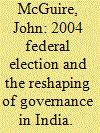

|
|
|
|
|
| Publication |
2009.
|
| Summary/Abstract |
Any assessment of political developments in post-colonial India inevitably begins with the Indian National Congress (INC). Not only is it the oldest political party in India, but it also assumed a seminal role in mobilising and leading the independence movement from the late nineteenth century through to 1947. Since then, it has dominated parliamentary politics until 1996, when it lost government to a coalition of parties, in part as a result of what was identified as deep-seated corruption in the ranks of its parliamentarians. Yet there were other factors that contributed to this decline, the most notable of which was the emergence and rise of the Bharatiya Janata Party (BJP). Indeed, it could be argued that, by the beginning of the twenty-first century, the BJP could be seen as the most significant development in defining the changing nature of Indian politics.
|
|
|
|
|
|
|
|
|
|
|
|
|
|
|
|
| 2 |
ID:
131147
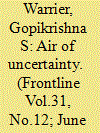

|
|
|
|
|
| Publication |
2014.
|
| Summary/Abstract |
Environment minister Prakash Javadekar will not have to worry about pressures from alliance partners. But one does not know how much space he is willing to carve out for himself and how much space the government is likely to give him.
|
|
|
|
|
|
|
|
|
|
|
|
|
|
|
|
| 3 |
ID:
137896
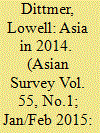

|
|
|
|
|
| Summary/Abstract |
THOUGH SOME MAY HAVE APPROACHED the centenary of the outbreak of World War One with a certain superstitious foreboding, 2014 in Asia was a pretty good year. As Xi Jinping put it in his May 21 address to the CICA (Conference on Interaction and Confidence Building Measures in Asia), ‘‘Asia today, though facing more risks and challenges, is still the most dynamic and promising region in the world.’’1 Economically, Asia remains the fastest growing region, averaging an estimated 6.1% GDP growth for the year, and the forecasting consensus predicts an even better next year. This is an impressive performance in the wake of the global 2009–13 slowdown and particularly the recent cooling of the Chinese locomotive. Politically, the headline for the year is democratic resilience, with relatively honest elections in Afghanistan, India, Bangladesh, Indonesia, and (jumping a few days into 2015) Sri Lanka. As for international security, on the other hand, it was a year of rising tensions: violent terrorist attacks in Afghanistan, Pakistan, Burma/Myanmar, India’s Assam, China’s Xinjiang; continuing confrontations over maritime boundaries in the South and East China Seas; and renewed fighting between India and Pakistan over Kashmir.
|
|
|
|
|
|
|
|
|
|
|
|
|
|
|
|
| 4 |
ID:
154771
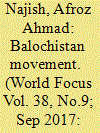

|
|
|
| 5 |
ID:
171982
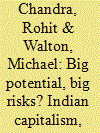

|
|
|
|
|
| Summary/Abstract |
This paper reviews India’s aggregate economic performance under the Modi/BJP/NDA administration through the prism of political economy. It argues that the inheritance of the UPA period was a combination of an unfolding “oligarchic capitalism” and a half-baked social democratic project. While the 2014 election victory was formally on a platform of “Minimum government, maximum governance” it always had deep ambiguities between a pro-business, pro-rules regime and an essentially nationalist project which subordinates commercial considerations. Some policy changes under this government, that we call Modi 1.0 – notably the GST reform and the Insolvency and Bankruptcy Code – constitute potentially substantive shifts to an efficiency-improving and rules-based approach. However, their effectiveness has been compromised by substantial delays, additional administrative burdens and increased uncertainty, not least over the actual implementation of the new rules. All this coincided with the legacy of a severe overhang in the financial system. This contributed to a chilling effect on private corporate investment. It has also gone alongside a continued major role of public sector banks and PSUs in the economy. The combination of an apparent increased concentration of mega-deals in some of the largest business houses, and continued, if anything rising, importance of state-managed subcontracting for infrastructure, has further contributed to the sense of an, at best, half-baked effort to reform India’s capitalism. A top-down economic nationalist stance, state-driven action, political resistance to reforms, and attacks on accountability institutions, will actually continue to threaten long-run development dynamics. The demonetization episode was only the most vivid example of a growth-dampening policy. At the beginning of the new government – Modi 2.0–these contradictions are intensifying. With the Covid-19 shock, the associated tensions will only become sharper.
|
|
|
|
|
|
|
|
|
|
|
|
|
|
|
|
| 6 |
ID:
023549
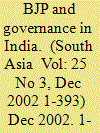

|
|
|
|
|
| Publication |
Dec 2002.
|
| Description |
1-393
|
|
|
|
|
|
|
|
|
|
|
|
|
|
|
|
| 7 |
ID:
142839
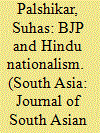

|
|
|
|
|
| Summary/Abstract |
Will the BJP pursue its Hindutva ideology while in power or will it now gradually become a ‘centrist’ party? Responding to this question, the present paper argues that the possibility that it would transform into a centrist party is rather dim for four reasons: 1) the mixing of Hindutva identity with the development agenda during the national election campaign in 2014; 2) the mild and covert pursuit of Hindutva by both party and government; 3) the dynamic, but deep-rooted relationship between Hindutva and the BJP; and 4) most importantly, the slow and imperceptible shifting of the middle ground of public opinion in India in favour of majoritarian (and therefore pro-Hindutva) sentiment.
|
|
|
|
|
|
|
|
|
|
|
|
|
|
|
|
| 8 |
ID:
157033
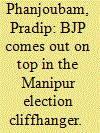

|
|
|
| 9 |
ID:
052360
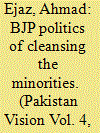

|
|
|
| 10 |
ID:
173326


|
|
|
|
|
| Summary/Abstract |
Five aspects of the BJP's election campaign contributed to its success in 2019. The first is the personal appeal of the prime minister, which again played a major role, like it did in 2014, as Narendra Modi led a hyper-personalized campaign. Second, this campaign focused on security-related themes which were especially relevant in the context of the India-Pakistan tensions. Third, the BJP campaign strategy was backed by the most formidable election campaign machinery assembled by any party in India since Independence. Fourth, the BJP saturated the public space with the prime minister's image, adroitly using the traditional mainstream media as well as social media. The party used religious appeal to address its core base of supporters while projecting the prime minister's image as a protector and sentinel. Fifth, the latter three aspects of the BJP's campaign were fuelled by unprecedented levels of campaign expenditure and by the opacity of political funding in India, which the BJP had made more impenetrable through the introduction of electoral bonds. The combination of these factors show that the 2019 elections were not business as usual; their singularity largely due to the decline of institutions regulating the electoral process, including the Election Commission of India.
|
|
|
|
|
|
|
|
|
|
|
|
|
|
|
|
| 11 |
ID:
141025
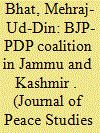

|
|
|
| 12 |
ID:
139625
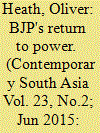

|
|
|
|
|
| Summary/Abstract |
Using constituency-level data, the article examines the BJP's vote swing at the State and Constituency level in India. Drawing on theories of electoral realignment, I examine the BJP's performance at the constituency level and investigate the extent to which the party drew voters from other parties (particularly Congress), mobilised new voters (via increased turnout), and appealed to the newly enfranchised (via increases in the size of the electoral roll). The results of the analysis show that the key to the BJP's success was its ability to mobilise new voters in places where it had previously not fared so well.
|
|
|
|
|
|
|
|
|
|
|
|
|
|
|
|
| 13 |
ID:
138173
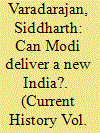

|
|
|
|
|
| Summary/Abstract |
On the surface, Narendra Modi has had a dream run in his first year as India’s prime minister. In May 2014, his Hinduright Bharatiya Janata Party (BJP) won 281 of the 543 seats in the Lok Sabha, the lower house of Parliament. This marked the first time since Rajiv Gandhi’s victory of 1984 that a party won a clear majority of its own and did not need coalition partners to form a government. After this triumph, Modi managed to install his trusted lieutenant, Amit Shah—who ran the interior ministry in Gujarat when Modi was chief minister of the state—as president of the BJP. Together with Shah, he has since gone on to win important state elections in Haryana, Maharashtra, and Jharkhand. In Jammu and Kashmir, the BJP did spectacularly well in the December 2014 elections and is now in government as part of the ruling coalition headed by the Peoples’ Democratic Party.
|
|
|
|
|
|
|
|
|
|
|
|
|
|
|
|
| 14 |
ID:
065124


|
|
|
| 15 |
ID:
102112
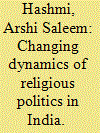

|
|
|
| 16 |
ID:
062183
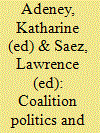

|
|
|
|
|
| Publication |
London, Routledge, 2005.
|
| Description |
294p.
|
| Standard Number |
0415359813
|
|
|
|
|
|
|
|
|
|
|
|
Copies: C:1/I:0,R:0,Q:0
Circulation
| Accession# | Call# | Current Location | Status | Policy | Location |
| 049669 | 324.254082/ADE 049669 | Main | On Shelf | General | |
|
|
|
|
| 17 |
ID:
131275


|
|
|
| 18 |
ID:
131135
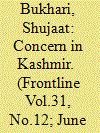

|
|
|
|
|
| Publication |
2014.
|
| Summary/Abstract |
The controversy over Article 370 has affected the psyche of the average Kashmiri and give rise to the fear that certain important right that the people of the state enjoy are going to be snatched away.
|
|
|
|
|
|
|
|
|
|
|
|
|
|
|
|
| 19 |
ID:
129385
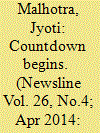

|
|
|
|
|
| Publication |
2014.
|
| Summary/Abstract |
Who will emerge victorious in India's May 2014 elections? Shehzada Rahul, the chaiwala form Gujarat, Narendra Modi, AK 49' Arvidn Kejriwala, or someone else? experts predict a land-slide victory for the BJP but history- as previously proven-may have something else in store for India.
|
|
|
|
|
|
|
|
|
|
|
|
|
|
|
|
| 20 |
ID:
159755
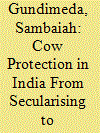

|
|
|
|
|
| Summary/Abstract |
Cow protection, a potent tool in the hands of cow vigilantes for atrocities against Muslims and Dalits, has become a heavily politicised issue in contemporary India. Its roots, connecting the themes of caste-Hindu religious sentiment, communalism and economic reasoning, can be traced to the late nineteenth century, though basic problems over the intriguingly complex use of cattle are clearly much older. This article relates contemporary cow protection debates specifically to Arya Samaj arguments against cow slaughter in the late nineteenth century and publication of a special issue of the journal Kalyan, titled Gau Ank, in 1945. The discussion shows how cow protection debates in the Constituent Assembly of India and in subsequent post-independence judicial verdicts were heavily influenced by these two earlier discourses. Analysing two landmark judicial decisions on cow slaughter, the article argues further that recent judicial endorsement of cow protection legitimises Hindu majoritarian sentiments in the law, while depriving millions of Indians, not just Muslims, of fundamental rights to food and livelihood. The conclusion attempts to consider some possible solutions to the current impasse.
|
|
|
|
|
|
|
|
|
|
|
|
|
|
|
|
|
|
|
|
|